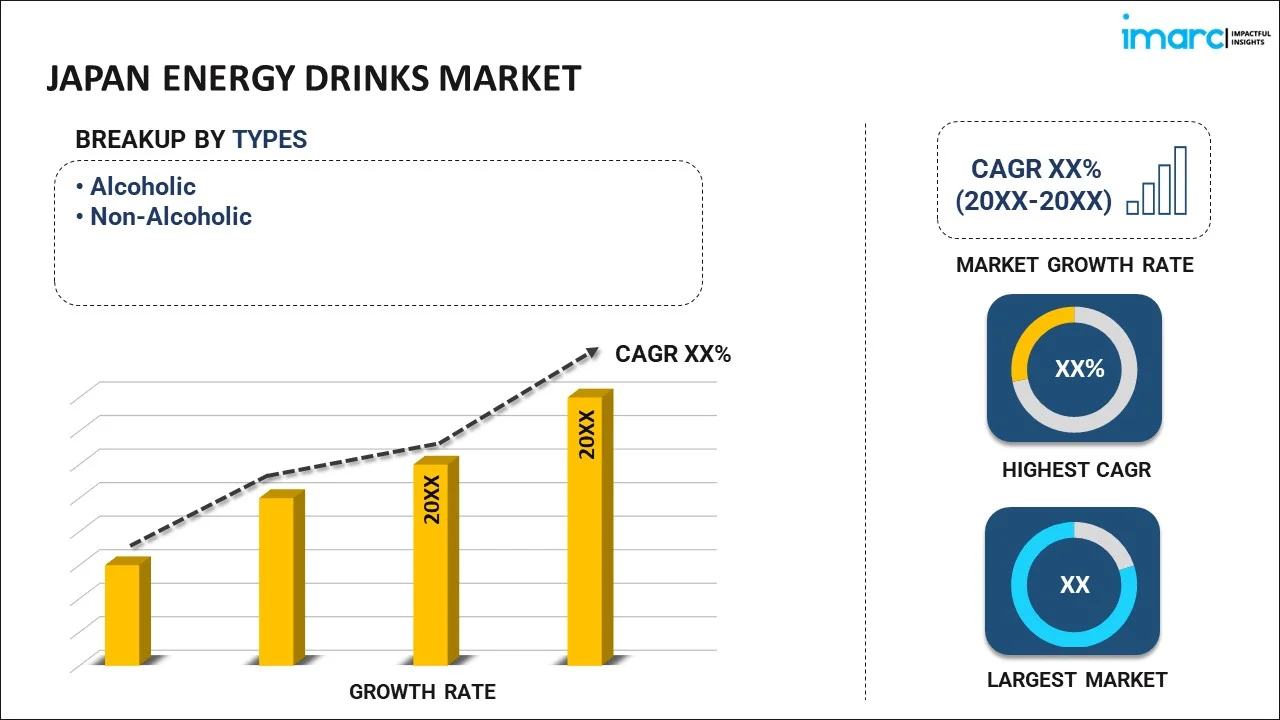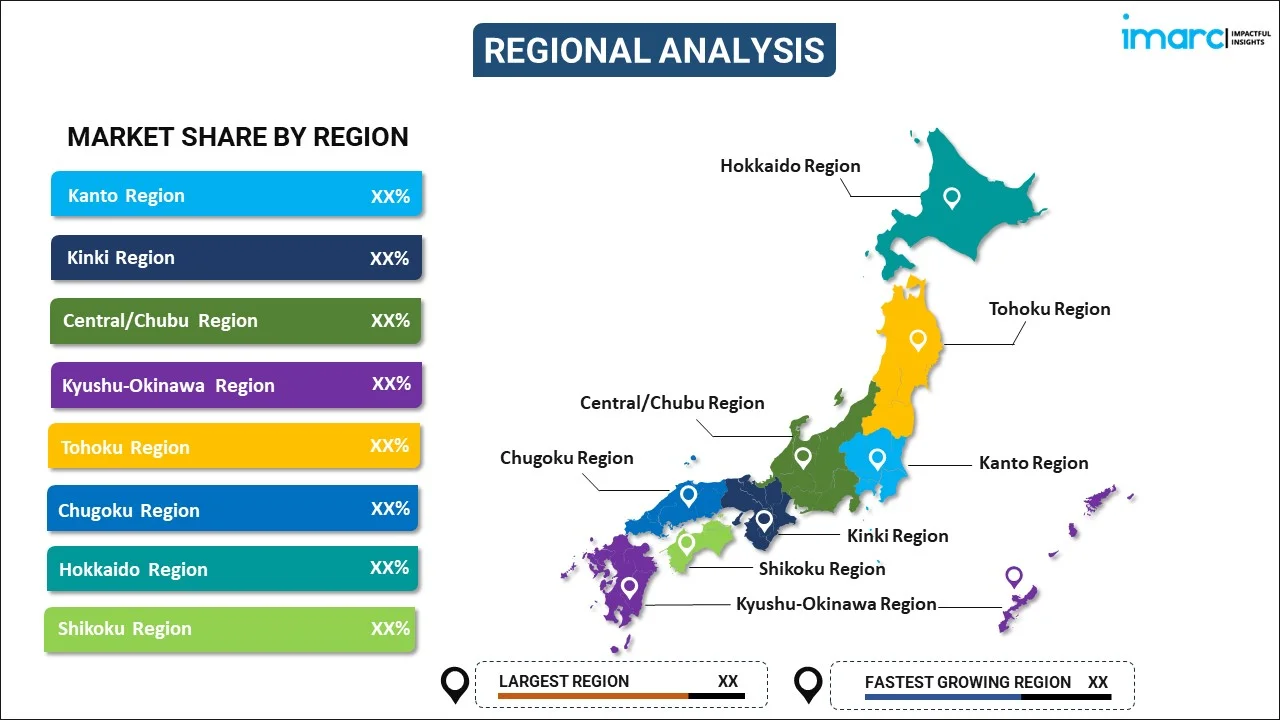
Japan Energy Drinks Market Report by Type (Alcoholic, Non-Alcoholic), End User (Kids, Adults, Teenagers), Distribution Channel (Supermarkets and Hypermarkets, Specialty Stores, Convenience Stores, Online Stores, and Others), and Region 2025-2033
Market Overview:
The Japan energy drinks market size reached USD 2.0 Billion in 2024. Looking forward, IMARC Group expects the market to reach USD 3.9 Billion by 2033, exhibiting a growth rate (CAGR) of 6.7% during 2025-2033. The increasing health and wellness consciousness among consumers, aggressive marketing and product innovation by energy drink companies, and rapid urbanization across Japan represent some of the key factors driving the market.
|
Report Attribute
|
Key Statistics
|
|---|---|
|
Base Year
|
2024
|
|
Forecast Years
|
2025-2033
|
|
Historical Years
|
2019-2024
|
| Market Size in 2024 | USD 2.0 Billion |
| Market Forecast in 2033 | USD 3.9 Billion |
| Market Growth Rate 2025-2033 | 6.7% |
Energy drinks are beverages formulated to provide a quick and temporary boost to physical and mental energy. They typically contain a combination of ingredients, such as caffeine, sugar, vitamins, amino acids, and herbal extracts, all aimed at increasing alertness and combating fatigue. The primary purpose of energy drinks is to improve stamina, concentration, and performance, making them highly preferred among individuals seeking a quick energy boost during periods of increased physical activity, work, or leisure. The key ingredient in energy drinks is caffeine, which is a stimulant that stimulates the central nervous system, promoting wakefulness and reducing the feeling of fatigue. The caffeine content in energy drinks is usually higher than that in traditional soft drinks or coffee, which contributes to the rapid and intense energy boost they provide. Additionally, energy drinks may contain other stimulating substances like guarana, taurine, and ginseng, which are believed to further enhance energy levels. While they offer a quick burst of energy, it is essential to consume them in moderation, as excessive consumption of caffeine and other stimulants can lead to adverse health effects such as increased heart rate, nervousness, and insomnia. At present, energy drinks are gaining immense traction across Japan, particularly among young adults, students, and individuals with demanding lifestyles.
Japan Energy Drinks Market Trends:
The increasing need for quick and convenient energy-boosting solutions due to the fast-paced and demanding lifestyles of Japanese consumers represents the primary factor driving the market growth. Moreover, the escalating adoption of energy drinks among individuals that face long work hours, academic pressures, and a desire for enhanced performance, as it offers a convenient option to stay alert and focused, is positively influencing the market growth. Apart from this, the rising health and wellness consciousness among the masses has augmented the demand for energy drinks formulated with natural and functional ingredients, such as low or zero-calorie options and those containing vitamins and electrolytes. Additionally, numerous product innovations by the leading energy drink manufacturers across the country to cater to the evolving preferences of health-conscious consumers have catalyzed market growth. Besides this, aggressive marketing and promotional strategies by energy drink companies, coupled with heavy investments in celebrity endorsements and sports sponsorships, increasing consumer awareness and interest in energy drinks, are propelling market growth. Furthermore, the rising strategic collaborations with retailers and convenience stores that expand distribution channels, ensuring widespread availability and accessibility of energy drinks throughout Japan, are contributing to the market growth. Other factors, including the introduction of innovative packaging and flavors, growing influence of cultural and social trends, and the heightening of sports and fitness, are also anticipated to drive the market further.
Japan Energy Drinks Market Segmentation:
IMARC Group provides an analysis of the key trends in each segment of the Japan energy drinks market report, along with forecasts at the country level for 2025-2033. Our report has categorized the market based on type, end user, and distribution channel.
Type Insights:

- Alcoholic
- Non-alcoholic
The report has provided a detailed breakup and analysis of the market based on the type. This includes alcoholic and non-alcoholic.
End User Insights:
- Kids
- Adults
- Teenagers
A detailed breakup and analysis of the market based on the end user has also been provided in the report. This includes kids, adults, and teenagers.
Distribution Channel Insights:
- Supermarkets and Hypermarkets
- Specialty Stores
- Convenience Stores
- Online Stores
- Others
The report has provided a detailed breakup and analysis of the market based on the distribution channel. This includes supermarkets and hypermarkets, specialty stores, convenience stores, online stores, and others.
Regional Insights:

- Kanto Region
- Kinki Region
- Central/ Chubu Region
- Kyushu-Okinawa Region
- Tohoku Region
- Chugoku Region
- Hokkaido Region
- Shikoku Region
The report has also provided a comprehensive analysis of all the major regional markets, which include Kanto, Kinki, Central/Chubu, Kyushu-Okinawa, Tohoku, Chugoku, Hokkaido, and Shikoku regions.
Competitive Landscape:
The report has also provided a comprehensive analysis of the competitive landscape in the market. Competitive analysis such as market structure, key player positioning, top winning strategies, competitive dashboard, and company evaluation quadrant has been covered in the report. Also, detailed profiles of all major companies have been provided.
Japan Energy Drinks Market Report Coverage:
| Report Features | Details |
|---|---|
| Base Year of the Analysis | 2024 |
| Historical Period | 2019-2024 |
| Forecast Period | 2025-2033 |
| Units | Billion USD |
| Scope of the Report | Exploration of Historical and Forecast Trends, Industry Catalysts and Challenges, Segment-Wise Historical and Predictive Market Assessment:
|
| Types Covered | Alcoholic, Non-Alcoholic |
| End Users Covered | Kids, Adults, Teenagers |
| Distribution Channels Covered | Supermarkets and Hypermarkets, Specialty Stores, Convenience Stores, Online Stores, Others |
| Regions Covered | Kanto Region, Kinki Region, Central/ Chubu Region, Kyushu-Okinawa Region, Tohoku Region, Chugoku Region, Hokkaido Region, Shikoku Region |
| Customization Scope | 10% Free Customization |
| Post-Sale Analyst Support | 10-12 Weeks |
| Delivery Format | PDF and Excel through Email (We can also provide the editable version of the report in PPT/Word format on special request) |
Key Questions Answered in This Report:
- How has the Japan energy drinks market performed so far and how will it perform in the coming years?
- What has been the impact of COVID-19 on the Japan energy drinks market?
- What is the breakup of the Japan energy drinks market on the basis of the type?
- What is the breakup of the Japan energy drinks market on the basis of the end user?
- What is the breakup of the Japan energy drinks market on the basis of the distribution channel?
- What are the various stages in the value chain of the Japan energy drinks market?
- What are the key driving factors and challenges in the Japan energy drinks market?
- What is the structure of the Japan energy drinks market and who are the key players?
- What is the degree of competition in the Japan energy drinks market?
Key Benefits for Stakeholders:
- IMARC’s report offers a comprehensive quantitative analysis of various market segments, historical and current market trends, market forecasts, and dynamics of the Japan energy drinks market from 2019-2033.
- The research study provides the latest information on the market drivers, challenges, and opportunities in the Japan energy drinks market.
- Porter's five forces analysis assist stakeholders in assessing the impact of new entrants, competitive rivalry, supplier power, buyer power, and the threat of substitution. It helps stakeholders to analyze the level of competition within the Japan energy drinks industry and its attractiveness.
- Competitive landscape allows stakeholders to understand their competitive environment and provides an insight into the current positions of key players in the market.
Need more help?
- Speak to our experienced analysts for insights on the current market scenarios.
- Include additional segments and countries to customize the report as per your requirement.
- Gain an unparalleled competitive advantage in your domain by understanding how to utilize the report and positively impacting your operations and revenue.
- For further assistance, please connect with our analysts.
 Inquire Before Buying
Inquire Before Buying
 Speak to an Analyst
Speak to an Analyst
 Request Brochure
Request Brochure
 Request Customization
Request Customization




.webp)




.webp)












